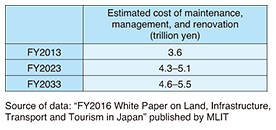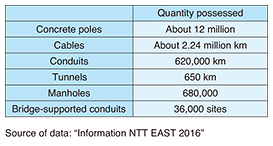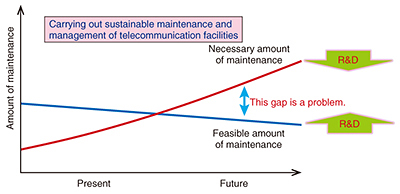 |
|||||||||||
|
|
|||||||||||
|
Feature Articles: Research and Development of Life-cycle Maintenance of Telecommunication Infrastructure Vol. 16, No. 1, pp. 12–18, Jan. 2018. https://doi.org/10.53829/ntr201801fa1 Direction of Research and Development of Life-cycle MaintenanceAbstractVarious social-infrastructure facilities have been constructed in Japan since the period of the country’s rapid economic growth. These facilities are currently aging, and the cost related to their maintenance, management, and renovation has become a serious issue. It is therefore necessary to improve the efficiency of the maintenance and management cycle to reduce this enormous cost and extend the service life of facilities. In this article, we use the term life-cycle maintenance to refer to the entire life cycle of the maintenance and management of telecommunication infrastructure, from maintenance planning to inspection, diagnosis, and repair, reinforcement, and renovation. We introduce the direction of research and development of life-cycle maintenance and present case studies. Keywords: life-cycle maintenance, safety and security, cost reduction 1. IntroductionSocial-infrastructure facilities in Japan such as roads, bridges, and tunnels were built extensively during the period of rapid economic growth and just after, meaning that at present, these facilities are aging. The results of a survey on the aging of social-infrastructure facilities under the jurisdiction of the Ministry of Land, Infrastructure, Transport and Tourism (MLIT) (Fig. 1) indicated that about 20% of facilities in fiscal year 2013 (FY2013; from April 1, 2013 to March 31, 2014) were 50 years older or more. That percentage is expected to reach approximately 40% in FY2023, and approximately 60% in FY2033. These estimates show a trend of rapid aging of facilities. The cost of maintenance, management, and renovation of these facilities was estimated to be about 3.6 trillion yen in FY2013. In 20 years, the figure is expected to be somewhere between 4.6 trillion yen (1.5 times the FY2013 cost) and 5.5 trillion yen (Table 1). It is therefore necessary to reduce the total cost associated with maintenance, management, and renovation and to maintain the budget at a certain level.
Japan must also prepare against disasters and deal with rapidly aging social-infrastructure facilities under various constraints. These constraints include a decline in the working age population accompanying an overall shrinking population due to aging and a low childbirth rate and a strict fiscal environment. In recent years, socioeconomic conditions have been undergoing great changes due to the development of technologies such as the Internet of Things (IoT), big data, artificial intelligence (AI), robotics, and sensors. Efforts to overcome a variety of challenges and achieve sustained economic growth are underway by creating innovations and dramatically increasing productivity. The application of these advanced technologies to social-infrastructure facilities is expected to improve safety, reliability, and economic efficiency. 2. Current state of NTT Group’s telecommunication infrastructureWithout exception, the conditions of the NTT Group’s telecommunication facilities (Fig. 2) are similar in most ways to the rest of Japan’s social-infrastructure facilities. In the areas of telephones and the Internet, equipment and devices such as servers and switches installed in telecommunication buildings are renovated when systems and technologies advance or diversify. In contrast, telecommunication infrastructure such as tunnels, conduits, manholes, concrete poles, branch wires, bridges, and wireless steel towers are maintained and managed for long-term use after their installation. The NTT Group currently operates a large number of telecommunication facilities (Table 2). It has been estimated that of these facilities, the proportion of manholes aged 50 years or older will reach about 60% in 2020 and 90% in 2030. For tunnels, the rate is estimated to be about 40% in 2030 and about 80% in 2040 [1]. Consequently, ensuring the safety and security of deteriorating telecommunication infrastructure while continuing to carry out maintenance and management has become a challenge.
Because of such conditions of the telecommunication infrastructure, the NTT research laboratories are developing technologies to maintain and improve the safety and security of telecommunication infrastructure, as well as to economically maintain and manage it. The maintenance and management cycle is shown in Fig. 3. Maintenance and management consists primarily of the steps of (1) maintenance planning, (2) inspection, (3) diagnosis, and (4) repair, reinforcement, and renovation. In the first four Feature Articles in this issue, this life cycle of maintenance and management in its entirety is called life-cycle maintenance. The direction of research and development (R&D) on life-cycle maintenance is introduced in these articles.
3. Direction of R&D of life-cycle maintenanceMaintenance and management of telecommunication infrastructure is carried out in accordance with management criteria determined in advance for each type of facility. Management criteria are standards for determining the inspection interval, inspection items, degree of degradation, and methods of repair, reinforcement, and renovation based on the extent of degradation. The stage of planning overall maintenance and management is called the maintenance planning stage. A maintenance plan is formulated based on the facility’s management criteria such as the inspection interval, inspection items, determination of pass/fail, and timing of repair, reinforcement, and renovation. In many cases, management criteria are currently dealt with uniformly for facilities using as references standards already established for general buildings worldwide. Because the inspection interval is uniformly determined, facilities with almost no degradation and facilities with progressing deterioration can take up about the same amount of labor. As a result, efficiency is reduced. However, if we adopt management criteria based on the degradation conditions of individual facilities, the maintenance and management cycle can proceed more efficiently. Inspection of facilities with almost no degradation can be omitted, and detailed inspection and repair and reinforcement can be applied to deteriorating facilities. In this way, the objective of the maintenance planning stage is to achieve efficient maintenance and management cycle operations through innovative facilities management. Next, inspection and diagnosis are carried out according to the maintenance plan. Currently, visual inspections are still conducted for many facilities. Despite the growing number of deteriorating facilities, the number of skilled workers is declining. As a result, implementing more efficient inspection and diagnosis has become a challenge. In recent years, the Fourth Industrial Revolution, as represented by IoT, big data, AI, robotics, and sensors, has been advancing globally, and technological developments have been progressing [2]. Specifically, technologies for predicting the timing of inspection and renovation are being developed by leveraging facility degradation data accumulated over long-term use, establishing models to predict degradation, and using big data such as facility data, inspection data, and weather and soil data. In this way, the removal of hindrances in the maintenance and management cycle is being sought with advanced inspection and diagnosis technologies. Repair, reinforcement, or renovation is carried out when the results of inspection and diagnosis indicate a facility exceeds predetermined criteria. Repair, reinforcement, or renovation is implemented taking into account the state of a facility’s degradation and damage. An appropriate level of repair and reinforcement is carried out for facilities with slight degradation to keep down the cost in the total life cycle. In contrast, for facilities with advanced degradation and damage, the sharp rise in the number of facilities to be repaired, reinforced, or renovated—and the associated cost—is a problem. Therefore, ways to improve the economic efficiency of methods of local reinforcement, repair, and renovation are being sought. Making facilities maintenance-free is also desired in the case of facilities requiring renovation by using materials with a long service life. Next, we describe the effects of R&D on life-cycle maintenance. Here we define the amount of maintenance needed due to facility degradation as the necessary amount of maintenance. We define the amount of maintenance that can be carried out by maintenance and management workers and the maintenance budget as the feasible amount of maintenance. To carry out sustained maintenance, the feasible amount of maintenance must exceed the necessary amount of maintenance. The necessary amount of maintenance increases greatly for telecommunication infrastructure facilities with advanced degradation. Furthermore, the feasible amount of maintenance is decreasing due to the shrinking number of skilled workers. If this situation is left unchecked, the necessary amount of maintenance will exceed the feasible amount of maintenance, and there is the danger that sustained maintenance and management will no longer be possible. Advances in inspection and diagnosis technologies such as those reported above and improvements in the economic efficiency of repair, reinforcement, and renovation methods can effectively boost the feasible amount of maintenance. Also, making facilities maintenance-free by prolonging and extending service life through repairs and reinforcements is effective in controlling the increase in the necessary amount of maintenance. As a result, it is possible to maintain the state in which the feasible amount of maintenance exceeds the necessary amount of maintenance, making it possible to carry out sustained maintenance and management of telecommunication infrastructure (Fig. 4).
4. Life-cycle maintenance-related effortsThree examples of NTT’s efforts in life-cycle maintenance are introduced in Feature Articles in this issue. 4.1 Improved efficiency of manhole inspection using technology to automatically determine degree of degradation [3]Degradation of telecommunication infrastructure facilities not only interrupts telecommunication services but is also a cause of road collapses. Such degradation can be highly problematic in society, so it is necessary to understand degradation conditions in a timely manner (inspection) and to carry out appropriate repair, reinforcement, or renovation based on the degree of degradation (maintenance planning and repair and reinforcement). Because many of these facilities in Japan were constructed more than 30 years ago, maintenance in the form of inspection and planning and repair and reinforcement is necessary for a great number of facilities. To efficiently execute the maintenance cycle, it is critical to model and predict degradation. Data accumulation is also considered to be important for modeling degradation and improving the accuracy of deterioration prediction. To improve inspection efficiency and accumulate high-quality images, NTT has developed technology to inspect manholes without having to enter the manholes by using a deterioration determination function (with an original image processing algorithm). A robotic arm equipped with a camera is inserted into the manhole; it captures images of the upper floor plate where degradation such as cracks exposing reinforced bars in concrete are noticeable and automatically determines the degree of degradation from the obtained images. The accuracy of degradation detection is improved by combining color detection and shape detection. In this way, workers can carry out tasks safely without the need to enter manholes, and in most cases, without having to drain water from manholes, which had been necessary in the past. As a result, inspection tasks can be greatly simplified. Because high-quality images can be accumulated, they can also contribute to improving the sophistication of future maintenance cycles. 4.2 Accelerated corrosion testing of anti-corrosion coatings simulating water absorption behavior [4]Outdoor steel structures such as wireless steel towers installed on NTT stations are applied with new paint or repainted if the results of inspection fall below maintenance criteria. The NTT Group possesses a large number of outdoor steel structures, and the cost associated with painting is enormous. This cost must therefore be lowered by selecting paints with strong anti-corrosion and longevity properties through accelerated corrosion testing and by lengthening the interval between repainting. The corrosion resistance and longevity properties of paints have improved. However, as a consequence, there is an increase in the number of cases where determining the quality of paints has taken more time than in the past. There is therefore a growing need to shorten the testing time. However, simply introducing stricter testing conditions can lead to the occurrence of different kinds of degradation in the actual environment. A type of paint with outstanding test results may not necessarily perform well in the actual environment. We therefore developed the NTT Cyclic Corrosion Test (CCT-N). This test can promote corrosion faster than conventional accelerated corrosion tests. It also uses new testing conditions that quickly mimic actual conditions in which the relative merits and deficiencies of test paints can be well observed. This new approach focuses on the water absorption/desorption behavior of test paints. The results of studying test conditions with this new method showed that water absorption was almost the same in the test environment as in the actual environment. We are achieving quick and similar testing conditions by adopting test conditions that hold water desorption to a minimum. 4.3 Deterioration mechanism-based risk assessment of telecommunication facilities [5]The aging of social-infrastructure facilities is becoming a social issue. To resolve this problem and to establish an efficient long-term maintenance plan, priority must be assigned to the great number of aging facilities that should receive attention, and when and what measures should be carried out. We adopt the concept of risk as an indicator of prioritization and are researching techniques for estimating this risk. The Feature Article “Risk Assessment of Outdoor Telecommunication Facilities Based on Deterioration Mechanisms” introduces our research on buried anchors. Risk assessment of buried steel structures considers that risk equals (1) the degree of degradation × (2) the consequences of failure. To devise a long-term and efficient plan, it is necessary to predict the degree of degradation of facilities in the future. However, because underground structures are particular environments that cannot be inspected visually, it is difficult to directly understand a facility’s degree of degradation. The extent of degradation also cannot be predicted statistically from past accumulated data. We are therefore seeking to predict deterioration by clarifying from the standpoint of materials science the deterioration mechanisms of buried steel structures and creating theoretical models. Degradation of buried steel structures proceeds primarily as a result of soil corrosion. To elucidate the mechanisms of soil corrosion, we are conducting buried soil tests outdoors and electrochemical experiments in simulated soil environments created in the lab. We set the goal of estimating environmental factors of soil from information on weather and soil conditions. We are also continuing to clarify relationships between the rate of corrosion and environmental factors under various soil conditions. Going forward, we seek to develop concrete theoretical models that predict deterioration from information on weather and soil conditions and calculate the consequences of failure as a risk factor (2). 5. Future developmentTo advance R&D on life-cycle maintenance, it is necessary to not just focus on technologies related to telecommunication infrastructure and the materials of facilities, as has been done until now. It is also necessary to apply diverse technologies such as IoT, big data, AI, robotics, and sensors. Toward this end, the NTT laboratories are actively collaborating with one another and with external organizations. Because there are also social infrastructures similar to telecommunication infrastructure, we are also seeking to expand our achievements externally. References
|
|||||||||||

















